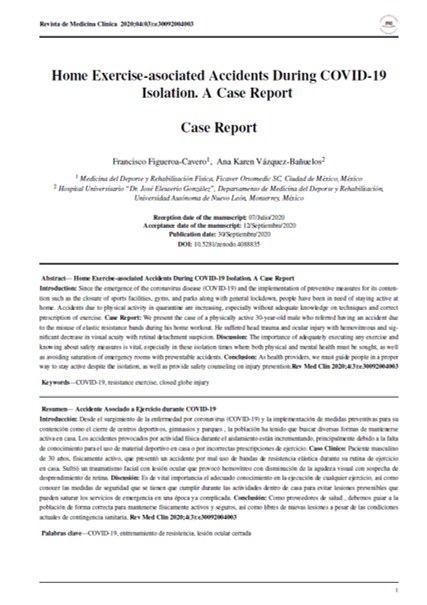Resumen
Introducción: Desde el surgimiento de la enfermedad por coronavirus (COVID-19) y la implementación de medidas preventivas para su
contención como el cierre de centros deportivos, gimnasios y parques , la población ha tenido que buscar diversas formas de mantenerse activa en casa. Los accidentes provocados por actividad fÃsica durante el aislamiento están incrementando, principalmente debido a la falta de conocimiento para el uso de material deportivo en casa o por incorrectas prescripciones de ejercicio. Caso ClÃnico: Paciente masculino de 30 años, fÃsicamente activo, que presentó un accidente por mal uso de bandas de resistencia elástica durante su rutina de ejercicio en casa. Sufrió un traumatismo facial con lesión ocular que provocó hemovÃtreo con disminución de la agudeza visual con sospecha de desprendimiento de retina. Discusión: Es de vital importancia el adecuado conocimiento en la ejecución de cualquier ejercicio, asà como conocer las medidas de seguridad que se tienen que cumplir durante las actividades dentro de casa para evitar lesiones prevenibles que pueden saturar los servicios de emergencia en una época ya complicada. Conclusión: Como proveedores de salud, debemos guiar a la población de forma correcta para mantenerse fÃsicamente activos y seguros, asà como libres de nuevas lesiones a pesar de las condiciones actuales de contingencia sanitaria.
Referencias
World Health Organization. Coronavirus disease (COVID-19) Situation Report - 136. 04 June 2020. https://www.who.int/docs/default-source/coronaviruse/situation-reports/20200618-covid-19-sitrep-150.pdf?sfvrsn=aa9fe9cf_4
Weber J, Javelle F, Klein T, et al. Neurophysiological, neuropsychological, and cognitive effects of 30 days of isolation. Exp Brain Res. 2019;237(6):1563-1573. https://doi.org/10.1007/s00221-019-05531-0
Jacubowski A, Abeln V, Vogt T, et al. The impact of long-term confinement and exercise on central and peripheral stress markers. Physiol Behav. 2015;152(Pt A):106-111. https://doi.org/10.1016/j.physbeh.2015.09.017
Medic, G., Wille, M., & Hemels, M. E. (2017). Short-and long-term health consequences of sleep disruption. Nature and science of sleep, 9, 151. doi: 10.2147/NSS.S134864
Nyenhuis, S. M., Greiwe, J., Zeiger, J. S., Nanda, A., & Cooke, A. (2020). Exercise and Fitness in the age of social distancing during the COVID-19 Pandemic. The Journal of Allergy and Clinical Immunology. in Practice. https://doi.org/10.1016/j.jaip.2020.04.039
Jiménez-Pavón, D., Carbonell-Baeza, A., & Lavie, C. J. (2020). Physical exercise as therapy to fight against the mental and physical consequences of COVID-19 quarantine: Special focus in older people. Progress in cardiovascular diseases. doi: 10.1016/j.pcad.2020.03.009
Jurak, G., Morrison, S. A., LeskoÅ¡ek, B., KovaÄ, M., Hadžić, V., VodiÄar, J., ... & Starc, G. (2020). Physical activity recommendations during the COVID-19 virus outbreak. Journal of Sport and Health Science. doi: 10.1016/j.jshs.2020.05.003
American College of Sports Medicine. Guidelines for Exercise Testing and Prescription. 9th edition. 2014.
Bird, S. P., Tarpenning, K. M., & Marino, F. E. (2005). Designing resistance training programmes to enhance muscular fitness. Sports medicine, 35(10), 841-851. https://doi.org/10.2165/00007256-200535100-00002
Iversen, V. M., Mork, P. J., Vasseljen, O., Bergquist, R., & Fimland, M. S. (2017). Multiple-joint exercises using elastic resistance bands vs. conventional resistance-training equipment: A cross-over study. European journal of sport science, 17(8), 973-982. https://doi.org/10.1080/17461391.2017.1337229
Bergquist, R., Iversen, V. M., Mork, P. J., & Fimland, M. S. (2018). Muscle activity in upper-body single-joint resistance exercises with elastic resistance bands vs. free weights. Journal of human kinetics, 61(1), 5-13. https://doi.org/10.1515/hukin-2017-0137
Gray, S. E., & Finch, C. F. (2016). Assessing the completeness of coded and narrative data from the Victorian Emergency Minimum Dataset using injuries sustained during fitness activities as a case study. BMC emergency medicine, 16(1), 24. https://doi.org/10.1186/s12873-016-0091-4
SADLER Sports and Recreation Insurance. (Internet) Available from: https://www.sadlersports.com/blog/thousands-injured-in-gyms-and-at-home-in-pursuit-of-fitness/
Rosignoli, L. M., Regan, K. A., Gray, M. J., Ohning, C. R., & Iyer, S. S. (2019). Exercise band-induced lens dislocations: A case series. American journal of ophthalmology case reports, 15, 100496. https://doi.org/10.1016/j.ajoc.2019.100496
Sibley, D., Abdalla, H., Gupta, A., & Ho, J. (2020). Exercise in isolating during novel coronavirus 19-A case report of bilateral ocular trauma from elastic resistant bands. Canadian Journal of Ophthalmology. https://doi.org/10.1016/j.jcjo.2020.05.001
American College of Sports Medicine. ACSM’s health/fitness facility standards and guidelines. 4th ed. Champaign: Human Kinetics; 2012. Available from: https://books.google.com.mx/books?id=Du96DwAAQBAJ&lpg=PP17&ots=VuPPTadpwm&dq=16.%09American%20College%20of%20Sports%20Medicine.%20ACSM%E2%80%99s%20health%2Ffitness%20facility%20standards%20and%20guidelines.%204th%20ed.%20Champaign%3A%20Human%20Kinetics%3B%202012&lr&hl=es&pg=PP1#v=onepage&q&f=false
Serious Steel Fitness, LLC.Virginia: Pull up band guide; 2016.
Picha, K. J., Almaddah, M. R., Barker, J., Ciochetty, T., Black, W. S., & Uhl, T. L. (2019). Elastic resistance effectiveness on increasing strength of shoulders and hips. The Journal of Strength & Conditioning Research, 33(4), 931-943. doi: 10.1519/JSC.0000000000002216
Ramage, E. R., Fini, N. A., Lynch, E. A., Patterson, A., Said, C. M., & English, C. (2019). Supervised exercise delivered via telehealth in real time to manage chronic conditions in adults: a protocol for a scoping review to inform future research in stroke survivors. BMJ open, 9(3), e027416. doi: 10.1136/bmjopen-2018-027416
Pimlott, N., & Carson, J. (2014). Promoting exercise and preventing injury. https://www.cfp.ca/content/60/5/404

Esta obra está bajo una licencia internacional Creative Commons Atribución-NoComercial-SinDerivadas 4.0.
Derechos de autor 2020 Francisco Figueroa-Cavero, Ana Karen Vázquez-Bañuelos

